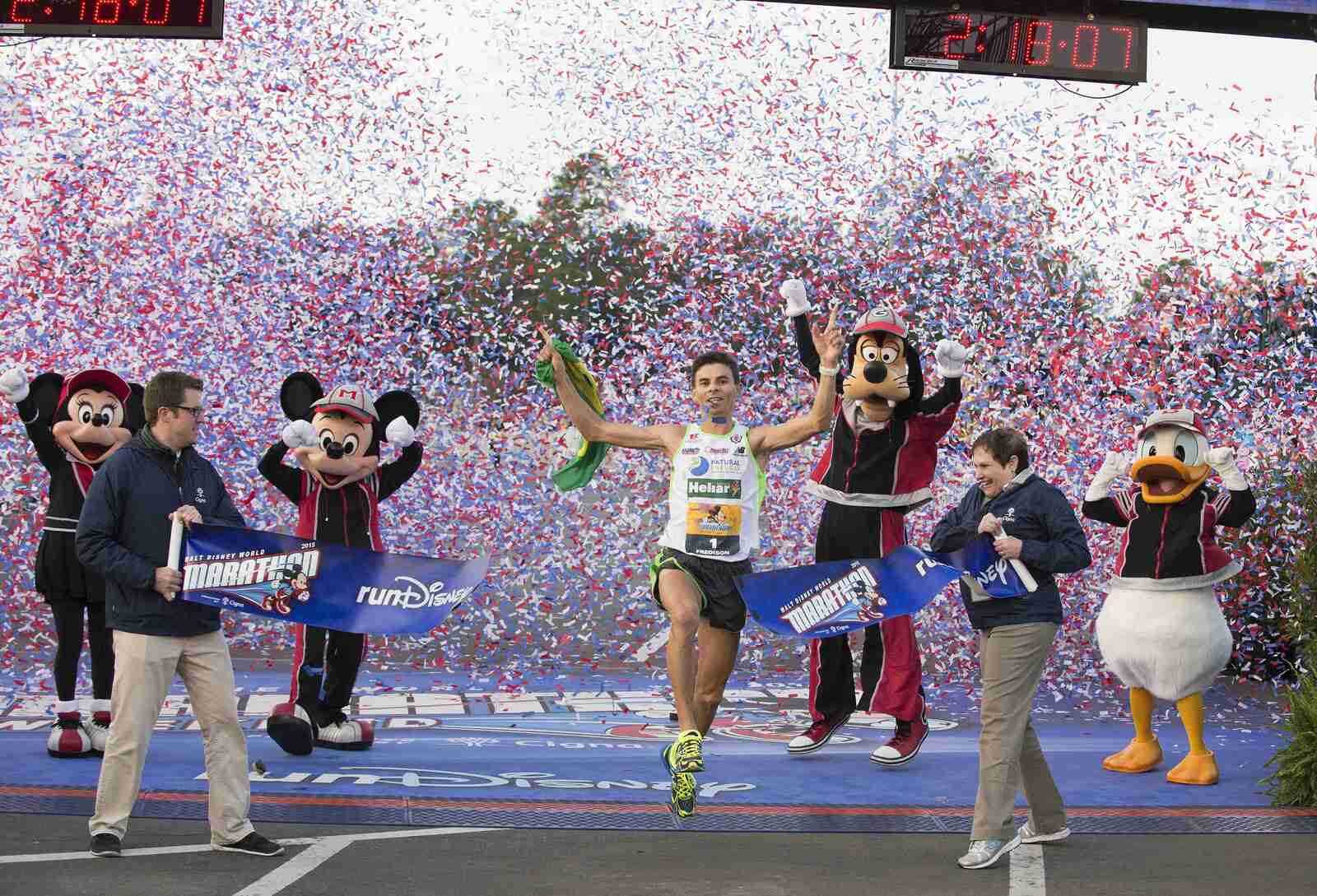

Featured
How To Go From Half Marathon To Full
Modified: August 21, 2023
Looking to take your running to the next level? Discover expert tips and strategies for transitioning from a half marathon to a full marathon in this featured guide.
Introduction
So, you’ve conquered the half marathon and now you’re ready to take on the ultimate challenge – a full marathon. Congratulations on your ambition! Making the leap from 13.1 to 26.2 miles is a significant milestone in any runner’s journey. It requires determination, dedication, and a well-thought-out training plan.
Preparing for a full marathon can be both exhilarating and daunting. It’s a journey that will push your physical and mental limits, but the feeling of crossing that finish line will make every step worth it. This article will guide you through the transition from half marathon to full marathon, providing valuable tips and insights to help you achieve your goal.
Before embarking on this new endeavor, it’s important to set realistic expectations. Running a full marathon is a tremendous undertaking that requires months of training and preparation. It’s not something to be taken lightly, but with the right mindset and approach, you can successfully make the transition.
Throughout your training, it’s essential to listen to your body and prioritize your overall health and well-being. While the physical aspect of training is crucial, it’s equally important to pay attention to your nutrition, sleep, and recovery. Taking care of your body will not only help prevent injuries but also enhance your performance on race day.
Remember, the journey to a full marathon is not just about the destination; it’s about the process. Embrace the challenge, stay consistent, and enjoy the gradual progress you’ll make along the way. This article will provide you with the necessary guidance and insights to help you navigate this exciting and demanding journey.
Setting a Goal
One of the most important steps in transitioning from a half marathon to a full marathon is setting a clear and realistic goal. Your goal will serve as a guiding light throughout your training and give you something to work towards. However, it’s important to set a goal that is challenging yet achievable, based on your current fitness level and experience.
When setting your goal, consider factors such as your previous half marathon time, the amount of time you have available to train, and any other commitments or limitations you may have. It’s also crucial to take into account your motivation and reasons for wanting to complete a full marathon. Whether it’s a personal challenge, a desire to test your limits, or a fundraising effort for a cause close to your heart, having a strong motivation will help keep you focused and committed.
Once you’ve determined your goal, break it down into smaller milestones. Consider incorporating intermediate races or long training runs to track your progress and build confidence along the way. Celebrating these smaller achievements will not only keep you motivated but also provide valuable insights into your training progress.
Remember, it’s important to be flexible with your goal as well. It’s okay to adjust and adapt your goal based on unforeseen circumstances or changes in your training. The key is to have a goal that challenges you but is also realistic and adjustable, ensuring that you maintain a positive mindset throughout your journey.
In addition to your time-based goal, consider setting secondary goals related to your overall performance, such as improving your endurance, maintaining a consistent pace, or finishing the race feeling strong. These secondary goals can provide additional motivation and help you stay committed to your training plan.
Lastly, write down your goal and place it somewhere visible. This will serve as a constant reminder of what you’re working towards and will keep you accountable. Share your goal with friends, family, or a running group for added support and encouragement.
Setting a clear and attainable goal will give you direction and purpose throughout your training. It will serve as a powerful motivator and help you stay focused on your journey to completing a full marathon. With your goal firmly established, it’s time to start increasing your mileage and building the endurance necessary for the challenge ahead.
Increasing Mileage
As you progress from a half marathon to a full marathon, one of the key aspects of your training will be gradually increasing your mileage. Your body needs time to adapt and build the endurance necessary for the longer distance. However, it’s crucial to do so in a safe and gradual manner to minimize the risk of injury.
Start by assessing your current weekly mileage and create a plan to gradually increase it. Aim to increase your overall mileage by no more than 10% each week. This gradual progression allows your body to adapt to the increased workload and reduces the risk of overuse injuries.
When increasing your mileage, pay attention to the quality of your runs, not just the quantity. Incorporate longer runs into your training regimen, gradually adding distance to your weekly long run. This will help build both physical and mental endurance while simulating the conditions of the full marathon.
In addition to increasing your long run, consider adding an extra day or two of running per week to your training schedule. This will allow you to accumulate more mileage and develop a consistent running routine.
However, remember that rest days are just as important as training days. Giving your body time to recover is essential for preventing injuries and allowing for muscle repair and growth. Plan for at least one or two rest days per week to allow your body to rest and rejuvenate.
When it comes to increasing mileage, it’s also important to listen to your body. If you start experiencing persistent pain or discomfort, it’s essential to address it promptly. Don’t push through injuries, as this can lead to more severe problems down the line. Seek guidance from a healthcare professional if needed and make any necessary adjustments to your training plan.
Remember, the goal is gradual and consistent progress. Be patient with yourself and trust the process. It’s better to progress slowly and remain injury-free than to push too hard and risk setbacks.
By gradually increasing your mileage, you’ll build the necessary endurance to tackle the full marathon distance. Stay focused, stay committed, and before you know it, you’ll be ready to take on the challenge.
Building Endurance
Building endurance is a crucial component of your training as you transition from a half marathon to a full marathon. Endurance is the ability to sustain prolonged effort, and it plays a significant role in completing the longer distance of a full marathon.
To build endurance, incorporate regular long runs into your training schedule. These runs should be done at a comfortable pace, allowing you to cover greater distances over time. Start with a distance that challenges you but is still manageable, gradually increasing the distance each week.
In addition to increasing the distance of your long runs, consider practicing time-based runs. Instead of focusing on the distance, run for a predetermined amount of time, gradually increasing the duration each week. This type of training helps your body adapt to running for longer periods, improving your endurance level.
Another effective way to build endurance is through interval training. Intervals involve alternating between periods of higher intensity running and periods of recovery. These workouts improve your cardiovascular fitness and help you sustain a faster pace over longer distances.
Include tempo runs in your training plan as well. Tempo runs are performed at a comfortably hard pace, slightly faster than your long run pace. These runs improve your lactate threshold, helping you maintain a faster pace for a more extended period.
Consistency is key when building endurance. Aim to run at least three to four times a week, with one long run and a mix of shorter runs and speed work. This consistent effort will improve your cardiovascular fitness and gradually increase your endurance levels.
As you focus on building endurance, it’s important to remember the importance of rest and recovery. Endurance training puts stress on your body, and rest days allow for proper muscle repair and growth. Incorporating active recovery such as stretching, foam rolling, or light cross-training activities can also help speed up recovery and prevent overuse injuries.
Finally, believe in yourself and trust your training. Building endurance takes time and dedication. There will be days when it feels challenging, but remember that every step you take is progress towards your goal. Embrace the process, stay consistent, and watch your endurance levels soar.
Incorporating Speed Work
Incorporating speed work into your training regimen is essential for improving your overall running performance as you transition from a half marathon to a full marathon. Speed work involves running at faster paces for shorter distances, challenging your body to adapt and become more efficient.
One of the most common forms of speed work is interval training. Intervals involve alternating between periods of higher intensity running and periods of recovery. For example, you could run at a fast pace for 1 minute, followed by a recovery jog for 2 minutes. Repeat this cycle for a designated number of repetitions. Interval training helps improve your cardiovascular fitness, builds speed, and enhances your ability to maintain a faster pace for longer durations.
Fartlek training is another effective method to incorporate speed work. Fartlek, which means “speed play” in Swedish, involves mixing up your pace during a run. During a fartlek run, you can choose landmarks or points along your route to sprint or increase your pace. The unpredictability of fartlek training makes it fun and engaging while improving your speed and endurance.
Tempo runs are another great way to incorporate speed work into your training. Tempo runs are performed at a comfortably hard pace, slightly faster than your long run pace. These runs improve your lactate threshold, enabling you to maintain a faster pace for extended periods. Start with shorter tempo runs and gradually increase the duration as your fitness level improves.
Hill repeats are an excellent option to build both strength and speed. Find a hill with a moderate incline and sprint up, focusing on maintaining good form and a strong effort. Jog or walk back down for recovery before repeating the cycle. Incorporating hill repeats into your training helps improve leg strength and endurance, making it easier to tackle inclines during your full marathon.
When incorporating speed work, it’s important to start gradually and listen to your body. Begin by adding one speed session per week and gradually increase the frequency and intensity as your fitness level improves. Be mindful of not overdoing it, as this can lead to fatigue or injury.
Remember to warm up properly before engaging in speed work to prepare your muscles and joints for the increased intensity. Also, don’t forget to include a cool-down and stretching session to aid in recovery and reduce the risk of post-exercise muscle soreness.
Incorporating speed work into your training will not only enhance your speed and performance but also provide variety and excitement to your workouts. It’s an essential component in your journey to completing a full marathon, allowing you to push your limits and achieve new personal bests.
Balancing Rest and Recovery
Rest and recovery are essential components of your training as you transition from a half marathon to a full marathon. It’s during these periods that your body adapts, repairs, and grows stronger, allowing you to perform at your best on race day.
First and foremost, it’s important to listen to your body and take rest days as needed. Rest days allow your muscles and connective tissues to recover from the stress of training. They help prevent overuse injuries and allow for proper muscle repair and growth. Incorporate at least one or two rest days per week into your training plan, giving your body time to rest and rejuvenate.
In addition to rest days, consider incorporating active recovery into your routine. Engage in activities such as stretching, foam rolling, or low-impact cross-training exercises like cycling or swimming. These activities can help improve circulation, reduce muscle soreness, and speed up recovery.
Sleep is another crucial component of rest and recovery. Aim for seven to nine hours of quality sleep per night. During sleep, growth hormone is released, which aids in muscle repair and recovery. It also helps regulate hormonal balance and supports overall physical and mental well-being.
Nutrition plays a significant role in recovery as well. Ensure you consume a balanced diet with an emphasis on nutrient-dense, whole foods. Include a variety of fruits, vegetables, lean proteins, and whole grains to provide your body with the necessary nutrients for muscle repair and recovery. Adequate hydration is also vital, so remember to drink enough water throughout the day.
Cross-training activities can be beneficial during periods of rest and recovery. Activities such as swimming, cycling, or yoga can help reduce the impact on your joints while still providing cardiovascular benefits and promoting mobility and flexibility.
It’s important to find a balance between training intensity and rest. Pushing yourself too hard without proper rest can lead to overtraining syndrome, which can affect your performance and increase the risk of injury. Pay attention to signs of fatigue, decreased motivation, and persistent muscle soreness, and adjust your training plan accordingly.
Lastly, don’t underestimate the importance of mental rest and recovery. Training for a full marathon can be physically and mentally demanding. Take time for yourself, engage in activities that help you relax and recharge, and practice stress-management techniques such as meditation or deep breathing exercises. A well-rested mind is just as important as a well-rested body.
By finding the right balance between training intensity and rest and recovery, you’ll optimize your performance and reduce the risk of fatigue or injury. Embrace the recovery process as an integral part of your training journey, and you’ll be well-prepared for the challenges ahead.
Nutrition and Hydration
Nutrition and hydration play a vital role in your training as you transition from a half marathon to a full marathon. Fueling your body properly before, during, and after your runs is essential to support your training, optimize performance, and aid in recovery.
Before your runs, focus on consuming a balanced meal that includes carbohydrates, proteins, and healthy fats. Carbohydrates are the primary source of fuel for endurance activities, so aim to include complex carbohydrates such as whole grains, fruits, and vegetables. Protein helps support muscle repair and recovery, so incorporate lean sources of protein like chicken, fish, beans, or tofu. Healthy fats from sources like avocados, nuts, and olive oil provide essential nutrients and aid in satiety.
During longer runs, it’s important to replenish your energy stores and maintain hydration. Consider consuming easily digestible carbohydrates in the form of gels, energy bars, or sports drinks. Experiment with different fueling strategies during your long training runs to find what works best for you. Hydration is crucial, so make sure to carry water or isotonic sports drinks and sip regularly throughout your run.
After your runs, prioritize recovery by consuming a post-workout meal that includes carbohydrates and proteins. This will replenish glycogen stores, aid in muscle repair, and facilitate recovery. Additionally, ensure you stay well-hydrated post-run to replace fluids lost through sweat.
Incorporating nutrient-dense foods into your daily diet is key to supporting your training and overall health. Include a variety of fruits, vegetables, whole grains, lean proteins, and healthy fats. These foods provide essential vitamins, minerals, antioxidants, and fiber to support your immune system and aid in recovery.
Timing is also important when it comes to nutrition and hydration. Aim to consume a pre-workout meal or snack about 1-2 hours before your run to allow for proper digestion. During your runs, plan to refuel every 45-60 minutes, depending on the duration of your run. After your runs, aim to consume a post-workout meal or snack within 30-60 minutes to optimize recovery.
Lastly, don’t forget about hydration. Proper hydration is crucial for optimal performance and overall health. Make sure to drink water throughout the day, not just during your runs. Monitor your urine color to ensure you’re adequately hydrated, aiming for pale yellow to clear urine.
Everyone is unique, so it’s essential to pay attention to your own body’s needs and experiment with different nutrition and hydration strategies during your training. Consider working with a sports nutritionist or registered dietitian to tailor a plan specifically to your needs and goals.
By fueling your body with the right nutrients and staying hydrated, you’ll give yourself the best chance of performing at your best during your full marathon training. Remember, proper nutrition and hydration are just as important as your physical preparation, so prioritize them throughout your journey.
Mental Preparation
Completing a full marathon requires not just physical strength but also mental fortitude. Mental preparation plays a vital role in your success as you transition from a half marathon to a full marathon.
First and foremost, visualize your success. Visualizing yourself crossing the finish line, feeling strong and accomplished, can help build confidence and motivation. Create a mental image of yourself overcoming any challenges you may encounter along the way.
Set positive affirmations and goals for yourself. Replace any self-doubt or negative thoughts with positive statements. Remind yourself of the hard work and dedication you’ve put into your training and believe that you are capable of achieving your goals.
Practice mental toughness during your training runs. Push yourself out of your comfort zone to grow stronger mentally. Incorporate challenging workouts that simulate the demands of the full marathon and learn to adapt to discomfort and fatigue.
Develop strategies to overcome mental roadblocks. When you hit a rough patch during your training or on race day, find techniques that help you stay focused and motivated. This might include breaking down the distance into smaller, manageable segments or using external cues to stay present.
Utilize visualization techniques throughout your training. Picture yourself successfully completing challenging workouts, maintaining a steady pace, and staying mentally strong during the race. This mental rehearsal can help boost confidence and reduce anxiety.
Work on staying present and being mindful during your runs. Let go of any past mistakes or future anxieties and focus on the present moment. Pay attention to your breath, your form, and the rhythm of your steps. This will help you stay in the moment and maintain a positive mindset.
Surround yourself with a support system. Share your goals and aspirations with family, friends, or running buddies who can provide encouragement and motivation. Having a strong support network can help you stay positive and accountable throughout your training.
Practice stress-management techniques outside of running. Engaging in activities such as meditation, yoga, or deep breathing exercises can help calm your mind and reduce stress. Taking care of your mental well-being is just as important as physical training.
Finally, embrace the journey and enjoy the process. Recognize that there will be ups and downs along the way, but each step is a part of your growth and progress. The mental strength you develop throughout your training will carry you through the challenges of the full marathon.
By focusing on mental preparation alongside physical training, you’ll be well-equipped to tackle the demands of a full marathon. Believe in yourself, stay positive, and keep your mental game strong.
Injury Prevention
As you transition from a half marathon to a full marathon, it’s crucial to prioritize injury prevention to ensure that you can stay on track with your training and reach your goal. Running a full marathon places a significant amount of stress on the body, so taking proactive steps to prevent injuries is essential.
First and foremost, listen to your body. Pay attention to any signs of pain, discomfort, or fatigue. If something doesn’t feel right, don’t ignore it. Address any aches or pains promptly to prevent them from escalating into more serious injuries.
Include a proper warm-up and cool-down routine in your training regimen. Warm up with dynamic stretches, such as leg swings or high knees, to prepare your muscles and joints for the workout. After your run, cool down with static stretches to help improve flexibility and reduce muscle soreness.
Gradually increase your mileage and intensity to allow your body to adapt and reduce the risk of overuse injuries. Avoid sudden spikes in mileage or overly challenging workouts that can put undue stress on your muscles and joints. Follow a structured training plan that includes rest days and incorporates gradual progression.
Strength training is vital for injury prevention. Include exercises that target the major muscle groups used in running, such as the hips, glutes, core, and legs. Strength training helps improve muscular balance and stability, which can reduce the risk of common running injuries.
Cross-training activities can also play a role in injury prevention. Engaging in low-impact activities such as swimming, cycling, or yoga can help reduce the repetitive stress on your body while still providing cardiovascular benefits and supporting overall fitness.
Prioritize proper running form. Focus on maintaining good posture, a relaxed upper body, and a slight forward lean from the ankles. Avoid overstriding, as this can lead to excessive impact and increased risk of injury. Consider consulting a running coach or physical therapist for a gait analysis to identify any form issues that need correction.
Invest in good-quality running shoes that provide proper support and cushioning. Replace your shoes regularly, as worn-out shoes can contribute to overuse injuries. Additionally, consider using orthotic inserts if you have specific foot mechanics or imbalances that may increase your risk of injury.
Pay attention to recovery strategies, such as foam rolling and massage, to reduce muscle tightness and facilitate recovery. Listen to your body’s need for rest and recovery, ensuring that you allow adequate time for muscle repair and growth between workouts.
Finally, maintain a balanced and nutritious diet to support your body’s overall health and recovery. Adequate intake of nutrients, particularly calcium, Vitamin D, and protein, can help support bone health and tissue repair.
Incorporating injury prevention strategies into your training plan will help minimize the risk of setbacks and keep you on track towards your full marathon goal. Take care of your body, be proactive, and prioritize injury prevention to ensure a successful and enjoyable training journey.
Race Day Strategies
Race day is the culmination of months of training and preparation. To ensure that you have a successful and enjoyable full marathon experience, it’s important to have a well-thought-out race day strategy. Here are some key strategies to consider:
Start by familiarizing yourself with the race course. Review the elevation profile, aid station locations, and any challenging sections of the course. Knowing what to expect will allow you to plan your pacing and mental strategies accordingly.
Set realistic goals for race day. Consider both time-based goals and secondary goals related to your performance and how you want to feel during the race. Having a range of goals provides flexibility and allows for adjustments if unexpected circumstances arise.
Stick to your race pace. It’s common to feel the excitement and adrenaline at the start of the race, but resist the urge to go out too fast. Start at a pace that feels comfortable and sustainable, gradually increasing as the race progresses. Consistency is key.
Use the aid stations strategically. Plan ahead for when and where you’ll take in fluids and nutrition. Experiment with different fueling strategies during your training to determine what works best for you. Take advantage of aid stations to stay hydrated and maintain your energy levels.
Maintain a positive mindset throughout the race. Distract yourself from negative thoughts by focusing on the present moment and using positive affirmations. Break the race down into smaller sections or milestones to make it more manageable mentally.
Utilize visual cues and landmarks along the course to stay motivated. Look for familiar faces in the crowd, dedicate each mile to someone or something meaningful, or envision yourself crossing the finish line. Creating personalized motivators can provide a mental boost during challenging moments.
Stay flexible and adapt to unforeseen circumstances. The weather, course conditions, or personal factors may require adjustments to your original race plan. Embrace the unexpected and be prepared to make on-the-spot decisions to ensure a successful race.
Engage with the crowd and fellow runners. Draw energy and motivation from the enthusiastic spectators and the camaraderie of fellow participants. Don’t hesitate to give and receive words of encouragement along the way.
Take full advantage of the crowd support during the final miles. The energy and cheers can be an incredible boost, pushing you through those last challenging moments. Use the excitement to propel yourself towards the finish line.
Celebrate your accomplishment as you cross the finish line. Take a moment to soak in the achievement and reflect on the hard work and dedication that got you there. Don’t forget to thank your supporters and take pride in completing your full marathon.
Remember, your race day strategy should be tailored to your own preferences, goals, and experiences. Use your training as a guide and trust in your abilities. With a solid race day strategy in place, you’ll be well-prepared to conquer your full marathon and revel in the sense of achievement that comes with crossing the finish line.
Conclusion
Congratulations on embarking on the journey from a half marathon to a full marathon! As you’ve learned throughout this article, the transition requires commitment, dedication, and careful planning. By setting realistic goals, increasing mileage gradually, building endurance, incorporating speed work, balancing rest and recovery, focusing on nutrition and hydration, preparing mentally, and preventing injuries, you’ll be well-equipped to tackle the full marathon distance.
Remember that the road to a full marathon is not just about reaching the finish line; it’s about the process itself. Embrace the challenges, setbacks, and triumphs you’ll experience along the way. Stay consistent with your training, fuel your body appropriately, take care of your mind and emotions, and prioritize rest and recovery. Each step you take is progress towards your ultimate goal.
As you approach race day, plan your strategy, visualize success, and keep a positive mindset. Be adaptable and prepared for unforeseen circumstances. Draw strength from the crowd support and the camaraderie of fellow runners. And remember, crossing that finish line will be an incredible achievement that you’ll cherish for a lifetime.
So lace up your running shoes, put one foot in front of the other, and embark on this extraordinary journey from a half marathon to a full marathon. Stay focused, stay committed, and believe in yourself. You have the power to accomplish this remarkable feat. Good luck and enjoy the adventure!









